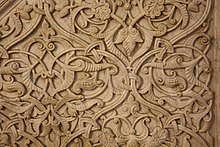Stilfragen
Stilfragen: Grundlegungen zu einer Geschichte der Ornamentik is a book on the history of ornament by the Austrian art historian Alois Riegl.
This position is argued in explicit opposition to that of the "technical-materialist" school, according to which "all art forms were always the direct products of materials and techniques"[2] and that ornamental "motifs originated spontaneously throughout the world at a number of different locations.
"[3] Riegl associates this view with the followers of Gottfried Semper, who had advanced a related argument in his Der Stil in den technischen Künsten; oder praktischer Ästhetik (Style in the technical arts; or practical aesthetics, 1878–79).
[4]As the technical-materialist position had attained the status of dogma, Riegl stated that "the most pressing problem that confronts historians of the decorative arts today is to reintegrate the historical thread that has been severed into a thousand pieces.
Here Riegl argues that motifs such as the lotus flower, although they may originally have been endowed by the Egyptians with symbolic significance, were adopted by other cultures that "no longer understood their hieratic meaning,"[9] and thereby became purely decorative.
"[12] The final two chapters are therefore presented as a continuous history of vegetal ornament from ancient Egypt through to Ottoman Turkey, in which individual motifs develop according to purely artistic criteria, and not through the intervention of technical or mimetic concerns.
Thus the styles change of necessity, or to put it differently: in a kind of 'retrospective prophecy' the art historian shows that artistic development was compelled to move in the direction in which in fact it did.



